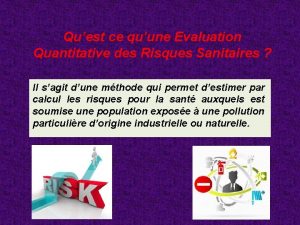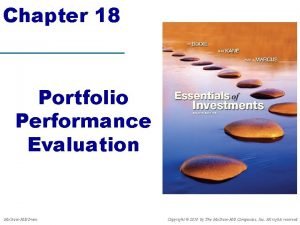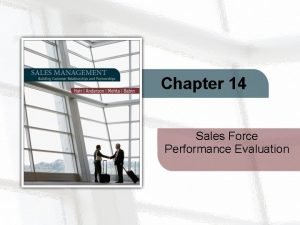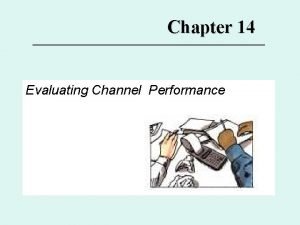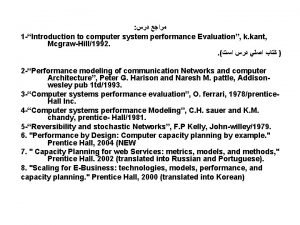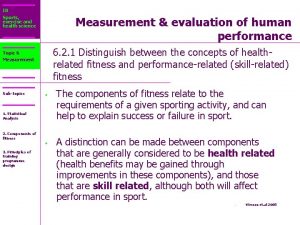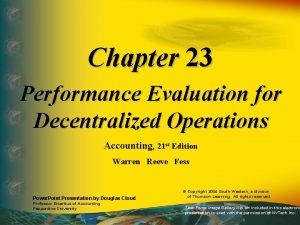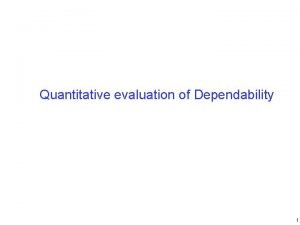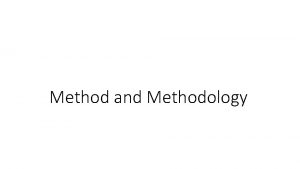Performance Evaluation Quantitative Method Performance Evaluation Quantitative Method










- Slides: 10

Performance Evaluation Quantitative Method

Performance Evaluation – Quantitative Method M/M/1 Abstract System/ Black Box SYSTEM Resource X N Arrivals Service Time Completions (A) (S) (C) Busy (B) – Length of time that the resource was observed to be in use Service Time B S= C Arrival Rate A = l T R Time (T) – Fraction of time the system is observed Throughput C = X T Utilization B = U T

Performance Evaluation – Quantitative Approach A- Arrivals C- Completions T- Time the system is observed B- Busy; fraction of time system is being used’ S- Avg. service time S= X- Throughput C = X T λ- arrival rate U- Utilization B C A l= T B C = * U S X C T U= B T

System Arrival and Completions 15 14 13 Customers in system 12 11 10 Jobs 9 8 7 Arrivals 6 Completion 5 4 3 2 1 Time 0 0 2 Accumulated Time in System 4 Avg. Residence Time 6 Little’s Law

Little’s Law n(t) Number of customers in the black box k N t 0 rk Total time that there are k customers in the black box

Performance Evaluation – Quantitative Approach W- Accumulated time in system N- Average number of requests in system Z- Avg. think time R- Response Time

Performance Evaluation – Quantitative Approach Utilization Law: Uk = X k S k Little’s Law: N = XR The Response Time Law: R = N/X – Z The Forced Flow Law: Xk = V k. X

Performance Evaluation – Example 1 An interactive system with 25 active terminals shows an average think time of 18 seconds. On average, each interaction causes 20 disk accesses. If the service time access per disk access is 25 ms. , and the disk is 30% busy. What is the average system response time in seconds? 25 terminals (N = 25) 18 sec average think time (Z = 18) 20 visits to specific disk per interaction (Vd = 20) 30% utilization of disk (Ud =. 30) 25 millisecond – avg. service requirement per visit to disk (Sd =. 025 sec) Disk Throughput: Xd = Ud / Sd =. 3/. 025 = 12 req/sec System throughput: X = Xd / Vd = 12 / 20 = 0. 6 interactions/ sec Response time: R = (N / X) – Z = ( 25 /. 6 ) – 18 = 23. 7 sec

Performance Evaluation – Example 2 During a measurement interval of 1200 sec. , an e-commerce site was monitored, and during this period, 4, 800 transactions were executed. We know that a transaction visits the web server 5. 2 times and the database server 3. 8 times. The database service time is 59 msec. and the Web service time is 35 msec. What is the average throughput of the database server and of the Web server? Calculate the Utilization of the two resources. T = 1200 sec C = 4800 completions Vweb = 5. 2 Vdb = 3. 8 Sweb = 3. 5 msec Sdb = 5. 9 msec X = 4800/1200 = 4 request/sec Xweb = Vweb * X = 5. 2 * 4 = 20. 8 io/sec Uweb = Sweb * Xweb =. 035 sec * 20. 8 io/sec = 0. 728 ( 72. 8 %) Xdb = Vdb * X = 3. 8 * 4 = 15. 2 io/sec Udb = Sdb * Xdb =. 059 sec * 15. 2 io/sec = 0. 896 ( 89 %)

Performance Evaluation Quantitative Method The End
 évaluation quantitative des risques
évaluation quantitative des risques Computer architecture performance evaluation methods
Computer architecture performance evaluation methods Portfolio performance evaluation problems
Portfolio performance evaluation problems Sales force evaluation process
Sales force evaluation process A channel member performance audit may be described as:
A channel member performance audit may be described as: Progress and performance measurement and evaluation
Progress and performance measurement and evaluation Computer system performance evaluation
Computer system performance evaluation Usmc master brief sheet
Usmc master brief sheet Measurement and evaluation in human performance 5e download
Measurement and evaluation in human performance 5e download Direct support professional performance evaluation
Direct support professional performance evaluation Performance evaluation for decentralized operations
Performance evaluation for decentralized operations
